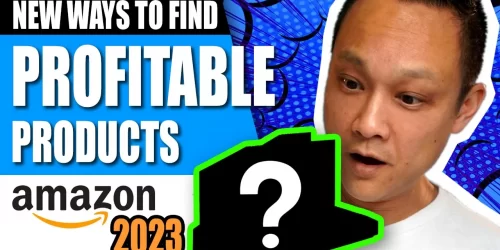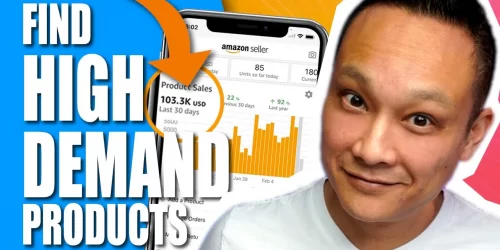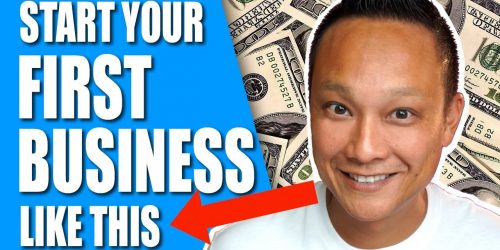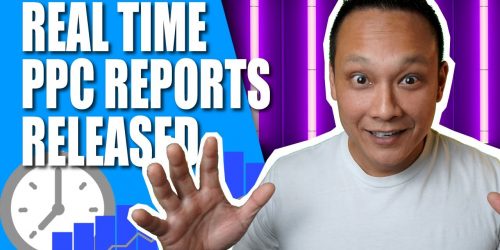5 Biggest Amazon PPC Problems in 2022 & How to Solve Them with Real PPC Data | Sellics
What’s up guys, my name is Crescent. With Amazon continuing to grow by leaps and bounds year after year, now only one of four companies in the world to reach the 1 trillion dollar valuation, is it still a good idea to be advertising on Amazon’s platform or should you be looking elsewhere? Which marketplaces, categories or products are best and which ones should you avoid? What is Amazon’s PPC service, what is it’s purpose and how can it benefit you? How can you improve or optimize your existing PPC campaigns, and of course, how much does PPC cost and how much should you budget for it? These are just some of the most common and pressing questions I get asked concerning Amazon’s Pay Per Click service and in this video, I’m going to answer these questions using real tangible data so I can demystify this topic and help you understand the current Amazon PPC climate so you can make better-informed decisions.
So, if you’re already selling products on Amazon, I’ll show you how you can compare how well your campaigns are performing against your competitors and where you can improve them. Or, if you’re looking for a new product to sell, how you can use aggregated PPC data to help you determine which marketplaces, categories, or products are the best and which to avoid.
Now, in order to answer these questions, first, smash the like button for the Youtube algorithm! It’ll help get this video out to other people just like you and I’d appreciate it. And with that said, we need to first understand what Amazon’s PPC system is, how it has been performing historically and what the current trends are in the industry. Why? Because knowledge is power. And if you’ve been following me for a while, you’ll already know that I’m very data-driven. I don’t make any decisions without first fully understanding what I’m getting into because the worst thing you can do is make a costly mistake due to your lack of due diligence. It’d be your own fault for being lazy.
Jay Shetty, an award-winning author and life coach actually said it best, “Knowledge is power, and it can help you overcome any fear of the unexpected. When you learn, you gain more awareness through the process, and you know what pitfalls to look for as you get ready to transition to the next level.”
Alright, so what is Amazon’s PPC service? PPC stands for Pay Per Click and it’s Amazon’s own advertising system where sellers can bid on keywords in order to have their ads show up in prominent locations within the search results. For example, if you didn’t already notice, when you do a search on Amazon, you’ll see listings that say Sponsored on them. These are ads placed within the search results by the PPC system. You’ll generally find these ads at the very top of the search results, the best location, as well as in the middle of each search page and at the bottom. You’ll also find them on the subsequent search pages and on the product detail pages. How the PPC algorithm determines where to place the ads is based on bids. The seller that bids the highest gets the best ad location, with the best ad spot being the top of the first page of the search results. The second highest bidder gets the next ad spot and so on. And if you didn’t know, sellers are charged each time someone clicks on their ad.
Alright, so now that you know what the PPC service is and how it works, should you be using it? Well, before I dive into the data, I think you need to first understand the fundamental difference between advertising on Amazon versus other platforms such as Google or Facebook. First of all, Amazon in itself is a sales platform. Think about why people visit Amazon? When a user does a search on Amazon, their search intent is to make a purchase. Whereas when someone does a search on Google for example, their intent is typically to find information, not to buy. This holds true for advertising on other platforms too like Facebook, the users intent for using the platform isn’t to buy something. This is the fundamental difference with searches performed on Amazon.
And fortunately for us, Sellics, the market leader in providing top-quality Amazon PPC data and market
intelligence has aggregated a vast amount of recent data for us to look at in a free downloadable report. In fact, this report spans the last two years, covering 7 Amazon marketplaces including North America and European marketplaces and 14 categories by analyzing over 2 million PPC ad campaigns, specifically the Amazon Sponsored Products campaigns. If you’d like to download the full report so you can take a look at it yourself, I’ll leave a link to this report in the video description below.
So, to specifically answer the question, should you be advertising on Amazon or should you be looking elsewhere, let’s take a look at what the report says.
If we look at ad costs, Amazon, the third-largest competitor in the digital advertising space, has caught up significantly on Google and Facebook and global advertising costs on Amazon remain lower than on many other platforms. Cost Per Click is $0.75 internationally and $0.87 in US for Sponsored Products, which in comparison is 68% lower than Google and 44% lower than Facebook, and other players like Instagram 79% less, 86% less than LinkedIn, and 13% less than Walmart.
The report also shows that in 2021, sellers’ revenues from Sponsored Products campaigns grew by 23% and conversion rates went up by 6.9%.
So, as you can see, advertising dollars go much farther and convert much higher on Amazon. Again, mostly due to the fact that people visit Amazon with the intent to make a purchase.
Now, if you’re unfamiliar with what Cost Per Click means or other PPC terms like Click Through Rate, Conversion Rate, Impressions, ACOS, I’ll briefly go over what each one means as we talk about them. But in a nutshell, these are KPI’s or key performance indicators. We can use these data points to gauge how well your PPC campaigns are performing. In this case, CPC or Cost Per click is how much you’re paying each time someone clicks on your ad. And this amount is directly tied to how much you bid for each keyword. The higher your bid, the better chance your ad will get shown in the best ad spots, however, the more you’ll pay each time someone clicks on your ad. And it should be pretty obvious from the name itself but you only pay when your ad is clicked, not when it’s shown.
And so as you can see, although the Cost Per Click is an excellent gauge of the level of competition for a niche, basically, the higher the cost, the higher to competition, the Sellics report also shows that the Cost Per Click for Sponsored Products ads increased by 22% overall on Amazon in 2021, however, Amazon still has the lowest ad costs compared to other platforms.
But more importantly, as we went over early, despite ad costs going up by 22%, sellers’ ad revenue, which is the number of sales generated from ad sales, increased by 23%.
Ok so, moving on. Which marketplaces, categories or products are the best and which ones should you avoid? Well, let’s take a look at the KPI starting with the Cost Per Click. We can see on this chart that the US marketplace clearly has the highest CPC, as well as the highest increase over the previous year, with the UK and Canadian marketplace second and third highest while the European marketplaces have the lowest CPC. You’ll notice that overall, the CPC across all marketplaces have trended upwards at 21% with the average cost growing from $0.62 to $0.75.
So, what does this mean and how can it help you? Well, for example, if you’re currently selling the US marketplace, you can significantly lower your ad costs by expanding to the Canadian marketplace and the opposite if you’re selling in Canada.
Now, if we take a look at the ACoS, which is the Advertising Cost of Sale, this measures how much you’re spending on ads in order to generate a sale. This is probably the most confusing KPI for most people. So let me give you an example. Let’s say you sold an item for $100 but it cost you $30 in ad clicks to make that sale, then the ACOS would be $30/$100 which is 30%. Which means your gross profit on this sale is $70. This is important to know because if your total costs for this product including the manufacturing, shipping and the Amazon fees more than than $70, then you didn’t make any money on this sale. That’s why it’s important to price your product accordingly and optimize your ACOS so that it is less than your profit margin.
As you can see here, although the ACOS has trended upwards slightly by 4% on average worldwide, it’s mostly in the US, Canada and UK marketplaces. The ACOS has remained relatively the same elsewhere.
And as we can see here, if we look at the ACOS alone, if you’re selling in the US, you may think that expanding into the Canadian marketplace may yield better returns since the ACOS is lower, however, you have to also consider the fact that the conversion rate in Canada is significantly lower than the US, 39% lower in fact. The conversion rate is how many ad clicks turn into a sale.
Also, take notice in this part of the report. It says comparing the marketplace trends demonstrates that there is no direct correlation between ACOS and CPC. And that even if you are selling in a highly competitive marketplace (or category), reflected in relatively high CPCs, there is no reason to be satisfied with poor returns. You need to optimize your listing and PPC campaigns.
Now, keep in mind that I’m just giving you a brief overview of how powerful this data is. The full report covers much more detail and you can go over the complete report yourself by downloading it for free. I’ll leave a link to it in the video description below. And while you’re down there, smash the like button for the Youtube algorithm!
Ok, now let’s take a look at which categories are the most favorable and which are not. The Sellics report analyzes and compares the benchmarks at the top level, or category level. For example, if we take a look here, Patio, Lawn & Garden is the top level category and there’s several sub categories within the top level that a product can fall under.
And it says here that when analyzing your campaigns, we recommend benchmarking your products at a lower level, whenever possible, so that you are measuring yourself against the most relevant competitors in your space. However, with thousands of categories going down six levels, such granular analysis would not be feasible in a report of this scope. So, what that means is, if you do want to analyze your own products or drill down deeper into specific categories, you can use Sellics free Benchmarker Tool. I’ll leave a link to that in the video description below for you.
Ok, so let’s take a look at the Click Through Rate. The CTR is how often an ad is clicked compared to how often it is being shown. The higher the CTR the better. We can see on this graph that while the overall benchmark in the US only slightly increased from 0.35% to 0.36%, the CTR within categories has changed significantly. We can see that the category with the best CTR is Office Products at 0.43% and the worst is Grocery & Gourmet Food at 0.33%. You can also see that Health & Household had the highest increase from the previous year at 10.1% and the Automotive had the worst drop in CTR at -3.9%.
Of course, there’s a lot of factors that can affect the CTR such as the quality of the main photo, pricing, and reviews as well as the type of product itself. As we can see here, products that are more technical or have more of an aesthetic value where buyers may want to do more comparisons can increase the CTR. Where as if price is the main differentiating factor or if brand recognition is dominant, the CTR can be much lower.
Now, if we take a look at the Cost Per Click, we can see that the overall benchmark in the US increased from $0.72 to $0.87 on average, Toys & Games however had the cheapest at $0.48 whereas Health & Household is the most expensive at $1.22. Grocery & Gourmet Food had the lowest increase in cost at 8.9%, $0.96 to $1.05, whereas Patio, Lawn & Garden had the higher increase at 33.8%, $0.58 to $0.78.
The CPC is an excellent gauge of how competitive a category is. The higher the costs, the more competitive it is. However, this may not be a bad thing. You can see that it says here, in a category with higher conversion rates, higher CPCs can be expected as each click is potentially worth more to the advertisers.
The CPC is also a great metric that you can use to estimate how much your PPC campaigns may cost so that you can budget accordingly. I’ll go over how you can do this this in the next part of the video.
Alright, now let’s take a look at the Conversion Rate. The conversion rate is how often an ad click turns into a sale. The higher the better. Again, we can see here that the benchmark in the US increased from 7.9% to 8.4% with Grocery & Gourmet Food being the top category at 13.9% That means, 1 out of every 7 ad clicks turned into a sale. The worst category is Clothing, Shoes & Jewelry at 5.4%. The category with the highest growth in Electronics at 15.3%, increasing from 5.9% to 6.8%, still not very good in my opinion and the worst being Toy & Games at -14.6%, falling from 6.7% down to 5.8%.
Moving on the the Average Order Value. This is the total amount spent in an order. We can see that the benchmark when up from $26.02 to $26.84 with the top category being Tools & Home Improvement at $44.99, an increase from $42.78. The bottom category is Grocery & Gourmet Food at $21.77. The biggest growth is Patio, Lawn & Garden at 12.4%, increasing from $33.76 to $37.94 and the biggest drop is Electronics at -7.4%, dropping from $45.37 down to $42.01.
The AOV is a tricky metric to analyse, however. You’d think that if the AOV is going up, that buyers are spending more so your profits are higher but that’s not necessarily the case. Over the last couple of years, rising manufacturing, material and shipping costs, supply chain issues and inflation play a significant role. And typically, sellers will pass these increased costs onto the buyer with price hikes, which in turn is what we then see as higher AOVs. The report actually summarizes this pretty well here. But one thing that I do want to mention is that there may be a lag in what we see in the report as far as AOV and ACoS because as costs go up for sellers, product pricing may not reflect the added costs right away as sellers may still have existing inventory or existing contracts with their supply chain at lower price points allowing them to keep their prices lower and competitive until they run out of stock or the contracts expire.
Now, let’s take a look at the ACoS. Again, the lower the ACOS the better. We can see that the average benchmark increased from 32.4% to 35.6%. The category with the best ACOS is Tools & Home Improvement at 24.8%. The worst is Beauty & Personal Care at a whopping 44.1%. And the category with the smallest increase is Beauty & Personal Care at 1.3%, still an extremely high ACOS though increasing from 43.5% to 44.1% and the category with the biggest increase is Toys & Games, increasing 35.4%, jumping from $25.9% to 35.1%
The ACoS is an extremely important metric to look at since it correlates directly to how much you’re having to spend on ads to make a single sale. I can’t stress enough how important it is to optimize your listing and ad strategy to ensure your PPC campaigns are profitable. We can see here that it says it simply means that sellers need an advertising strategy, optimized ad campaigns and product page content that are crafted to meet the requirements in their niche.
Now, again if you want to dive deeper into the sub categories, such as if you’re already selling a product on Amazon, you can get a detailed report for your products by using the free Benchmarker tool. For example, in the report, we can take a look at the Electronics category here. The overall performance in Electronics can be seen here. The CTR has gone up by 1% at 0.36%, the CPC has gone up by 24% at $0.76, conversion rate has gone up by 15% to 6.8%, the AOV has gone down by -7% to $42.01 and the ACOS has gone up by 15% to 30.9%
However, if we niche down, we can see that the best performing sub category for the CTR is actually Camera & Photo at 0.44% which went up by 9% and it also has the best ACOS at 21.1% even though it has gone up by 8% from the previous year. And although still pretty low, the Conversion Rate also went up by 29%.
Conversely, the subcategory with the worst CTR is Headphones at 0.29%. It also has the worst CPC at $0.84 and second to worst ACOS at 38.7%
So, as you can see, this can be extremely helpful data for you to look at if you’re already selling products on Amazon and you’re looking to optimize your PPC campaigns. You can directly compare your performance to the benchmarks of your competitors. Again, if you’re interested, this data is completely free. I also have a video that goes over how to analyze the data and I’ll leave a link to the video and Benchmarker Tool in the video description below.
And lastly, we can take a look at the overall performance of all of the categories in this table here. Again, we can see that Office Products has the best CTR at 0.43% and House & Household has the biggest increase at 10.1%. Toys & Games as the cheapest CPC at $0.48 although it also has the highest increase at 28.5% from the previous year. Grocery has the best Conversion Rate at 13.9% with Clothing and Toys having the worst at 5.4% and 5.8%. Tools & Home Improvement has the highest AOV at $44.99 as well as the best ACoS at 24.8%.
So as you can see, this data can help you determine how well your current products are doing or if you’re looking to find products to sell, you can focus on the categories with the best KPI’s and you can avoid or at least be aware of the categories that have poor KPIs before committing to a new product idea.
For example, I would stay away from Toys & Games. I never recommended this category anyways because of how competitive it is, the higher returns and short life cycle of the products but this data helps verify that. It has the highest increase in CPC while the conversion rate fell the most and it has one of the worst ACoS. Categories I would focus on are Home & Kitchen, Industrial & Scientific and Office Products. They have among the highest CTR, low CPC, highest Conversion Rate, high AOV and better than average ACOS. Again, you can download this report for yourself if you want to take a look at this more closely.
Alright, the question I see asked all the time, how much does PPC cost? Or how much should I budget for PPC? Well, the standard answer you see is usually, it’s hard to say because there’s so many different factors. And if we follow the typical advertising rule of thumb, generally, you want to allocate around 20-30% of your budget to advertising and marketing. But that doesn’t really help someone that’s just starting, most people want an actual dollar amount.
https://smallbusiness.chron.com/average-marketing-advertising-budget-company-30993.html
So, I’m going to show you a pro-tip here on how you can estimate how much your PPC costs can be so you can budget accordingly. Now, if you’re already selling on Amazon, you should have a good idea of how many units you’re selling each month or if you’re in the product research phase, you’re probably using a product analysis tool that gives you a monthly estimate of the sales for the product. So, with that monthly sales figure, you can use the Sellics report to help give you an estimate on how much your PPC costs will be by doing some simple math. But first, a couple of things to consider. This is just an estimate, it’s just to give you an idea of how much you could be spending on PPC. And second, this assumes all of the sales are from your PPC ads, such as when you’re launching a new product and the majority of your initial sales will most likely be from PPC, so keep this in mind.
Now, I realize for some of you math may not be your strong point, so you may want to watch this part a few times. Let’s say for example we’re selling something in the Home & Kitchen category. We can see that the average CPC is $0.68, the ACOS is 35.4% and the AOV is $29.30. Now, let’s say you’re monthly sales is 300 units.
Now, by doing some simple math, we can see that our monthly sales revenue is 300 units x $29.30 which is $8790. Since the ACOS is 35.4%, we know that we’re spending 35.4% of the sales revenue on ads. So $8790 x 35.4% is $3111.66. That means, you’re spending $3111.66 on your PPC ads each month. Now, if the product your selling isn’t $29.30, then simply substitute that with the price of your product.
Now, keep in mind that that PPC cost isn’t coming directly out of your pocket. The $3111.66 is deducted from your sales revenue. So, having sold $8790 worth of products, Amazon will deduct the $3111.66 and give you the remaining balance. It’s a little more complicated than that, but that’s the jist of it.
So, what that means is if your total costs for the product is less than the remaining balance, then you’re not having to pay anything out of pocket. Basically, if you subtract $3111.66 from the sales revenue $8790, the remaining balance or the gross profit is $5678.34.
Therefore, if you’re total costs, that’s manufacturing, shipping and the Amazon’s fees are less than $5678 for those 300 units, then you’ve made money and covered the PPC costs. Otherwise, if your costs are more than $5678, then you’ll have to pay the difference out of pocket. Basically, to break this down, $5678 divided by 300 is $18.93. This is your gross profit. If your costs per unit is less than $18.93, then you made money.
Now, if you want to get a more accurate estimate, you can niche down and use the KPI’s of your products sub category rather than the top level category KPI’s. And to get those figures, you can use the free Benchmarker Tool.
Ok? I know this may be confusing so feel free to watch this part over again or I have a video that goes over how to calculate your profit and fees and I’ll leave a link to it in the video description.
Alright, so I hope I’ve showed how powerful this data is and how you can use it effectively. Knowledge is king. So, if you want to download this Sellics report so you can go over it yourself or if you want to analyze your own products with the free Benchmarker Tool, I’ll leave links to both in the video description below.
If you want to get in touch with me, you can find all of my contact details in the video description below. I’d love to hear your thoughts, so leave a comment or question in the comment section below, I answer every single one.
And as always, if you found value in this video, consider subscribing. And do me a favor smash that like button for the youtube algorithm it really does help me out and I’d appreciate it, and ring the bell so you never miss a future video! Alright, thanks for watching!





